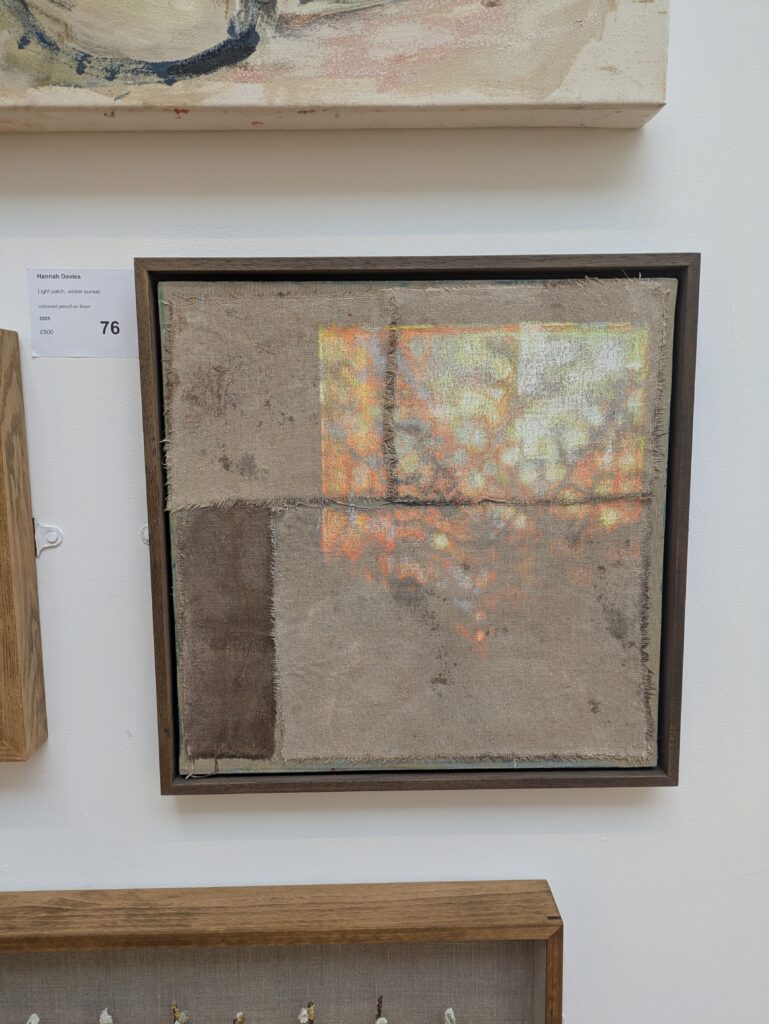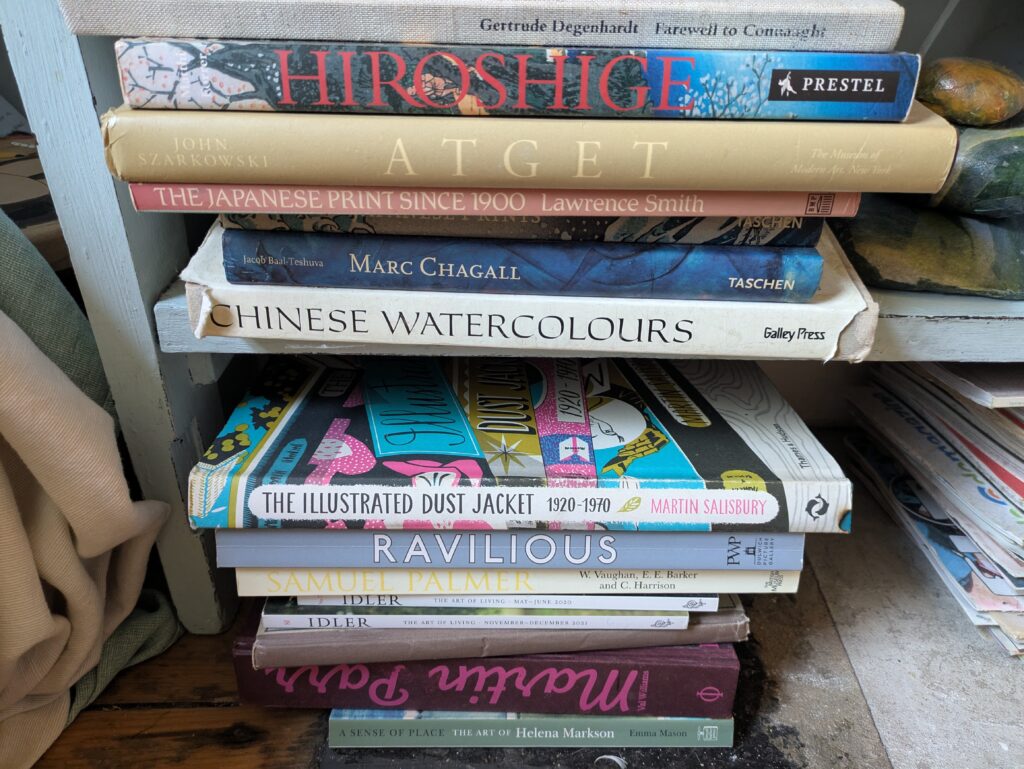‘There is no such thing as a copy really. Everything is just a translation of something else.’ David Hockney
Three things influencing this blog post: Reading ‘Spring Cannot be Cancelled: David Hockney in Normandy’ (by Martin Gayford), visiting the Royal West of England Academy Open Exhibition and having to choose a piece of art for myself in a gallery.
And four ideas: influence, translation, copying and really, really liking something. The difference between them takes a little time to cultivate as an artist I think.
I’ve often felt that what you like, artistically speaking, shouldn’t necessarily be what influences your art and vice versa. It’s very easy these days to get mixed up between liking something, being attracted to it, and thinking that it should influence your own work- mainly because of the omnipresence of visual art we’re exposed to via Instagram and the like.
I actually love seeing art I would never see in a gallery, by non-famous artists, and this is the joy and advantage of Instagram. But it also exposes us to so much art that probably shouldn’t become an ‘influence’- it becomes harder and harder to discern what we are good at, what our hands like to do, and what we want to say with our art.
I see it as a sign of artistic maturity to realise, and truly accept, that you may never make art like the art that you greatly admire, even love.
The David Hockney book (in fact all of the books that have his writings and musings on art- and there are many) is revelatory because it shows how much he is influenced by art history, the greats of 19th and 20th century art, how he wrestles with those influences, and yet makes art that is truly and completely his own.
He has, in the past, made a chronological wall of postcards and copies of art from the Byzantine period through to the late Renaissance – he calls it the ‘Great Wall’. This was as a research method when he was writing his book about optical lenses, but it revealed the slow movement of change in art, the threads that run through, the influences, the cycles and circles of influence, all together. It is indeed a rarity (if it ever happens) to see this line of blurred and soft influence all in one go- and probably needs to be done via copies rather than real pictures.
And I think that’s at the heart of ‘influence’- it’s slow, it should probably be part of your being. Changes will ebb and flow, rising to the surface at times and sinking below at others. The difference between surface level changes and the depths from which your art comes.
Revisiting Hockney’s art recently (I went to the retrospective ’25’ in Paris in April) I was struck by the threads I could see through the work, his taking of the canon of Western art, and remaking it through his own filters and perspective. So where I could see the Bayeux tapestry, Breugel, Van Gogh, Samuel Palmer and Cotman in his art, he was also producing work that was totally unique, spun through his artistic life, passions and skills. It’s a real pleasure to see both at the same time.
Looking at Hockney’s long career and the different work he’s made, it’s apparent how threads had resurfaced, sometimes decades after he’d first seen or tried something.
So, lessons I’m learning from him: Patience. Allow what you’re exposed to, to percolate, settle and compost, and then- the trick of it- allow and enable it to re-surface.
I believe Picasso was the absolute master of this- Hockney struggles with his influence, but actually I think Picasso really reached a state of enlightenment, whereby he was able to let all his influences flow though him at will, without force or judgement, into whatever he was making. That’s what made his art so him and so timeless.
It made me realise something else about ‘liking things’, as opposed to influences- though we may not use something as an influence in our own art, when we are attracted to something, it is giving us precious information about ourselves.
There’s something that pulls us, and though the technique or subject may not be something we want to emulate, it is worth asking the question ‘what can I take from this?’ Maybe one mark, maybe a feel or atmosphere, maybe an emotional reaction, maybe one colour. And that thing may take years, maybe decades, to make itself known in our art, if ever. The question ‘why do I like it?’ is the key.
Brian Eno has said ‘What is it I really like? That is the most important question you can ask in your life’, and I think he’s right, though this becomes harder to discern as we are exposed to so much through our screens. Though there is so much to see nowadays, I think the trick is to let your eyes skim over and notice when there is a visceral pull towards something. Then ask ‘why?’.
I recently had the pleasure of choosing something (up to a certain price) at a gallery recently, for a prize. I found it interesting because I was immediately drawn to some ‘decorative’, mid-century’ style ceramics, and though I looked around the gallery at lots of other things that I should have liked, it was those ceramics that I came back to again and again, and eventually chose to take home. Something about the simple shapes, the compositions, the all-roundedness of them, the scratchy lines, the layers. It was a good exercise in figuring out why I’m attracted to certain things, even though I would never use that technique, texture or subject.
A more expansive and overwhelming version of this experience occurred when I visited the RWA open exhibition (the South West’s equivalent of the RA Summer show). It’s floor to ceiling art, all by different artists. I found it interesting not least because I realised, that much like Hockney’s Great Wall of Western Art, it is a rare thing to be faced with so MUCH art, and every piece so different.

I have total admiration for the hangers, who try to find relationships between pieces. And so yes, it is curated, the pieces displayed in someone else’s vision. But still, it is a wonderful opportunity to allow the eye to wander, and become aware of what attracts you. Which is exactly what I did. I decided I would not force myself to look at everything, but just let my eye settle on things that gave me pleasure, intrigued me, that I felt a gut reaction to, and leave the rest behind.
It was a very interesting way to view art, not least because it told me so much about my particular taste.

I can only comment on my own influences in so far as they are ones that have been with me for many years, resurfacing at intervals- Hiroshige, Barbara Rae, Norman Ackroyd, Fra Angelica, Turner, Eric Ravilious, mid- 20th century illustration, photography, poetry.
I’m still percolating things that will influence me in the coming years, and have only a dim awareness of them right now. I just have to trust that I’m exposing myself to good things, that I will act on the attraction and pull of what I like (and ask ‘why?’ enough), and that the elements that should and could influence what I make, find their way into my hands, heart and eyes.